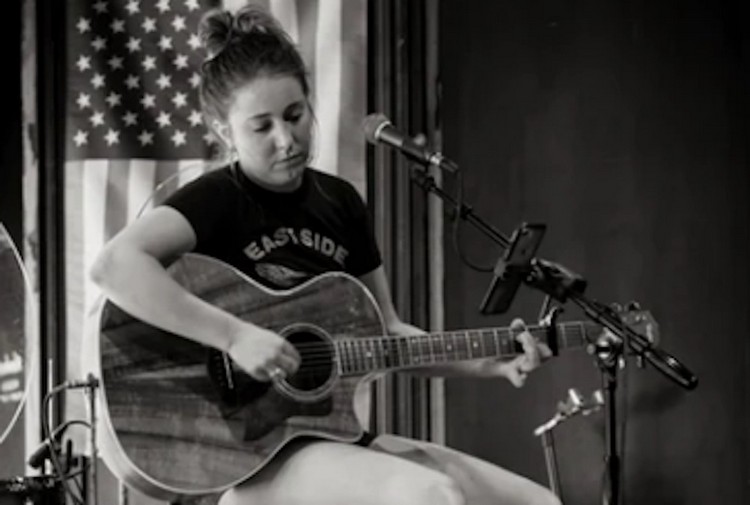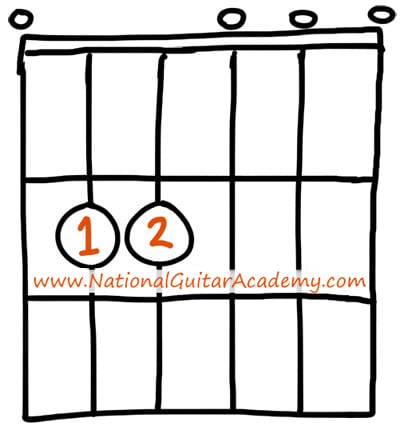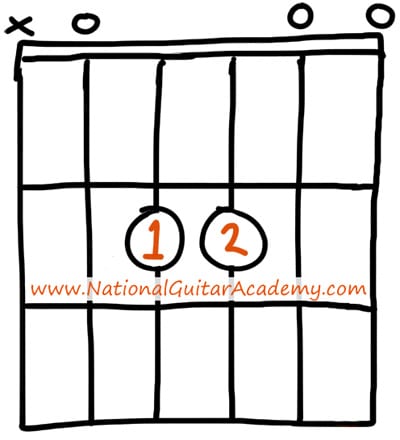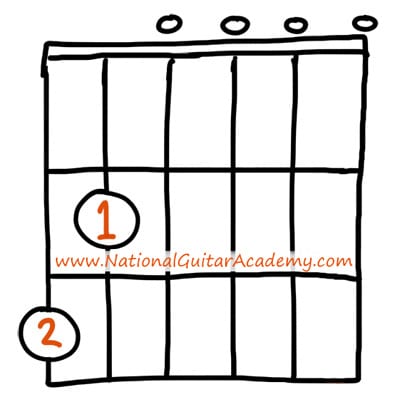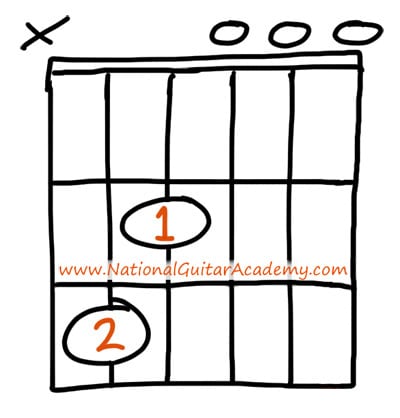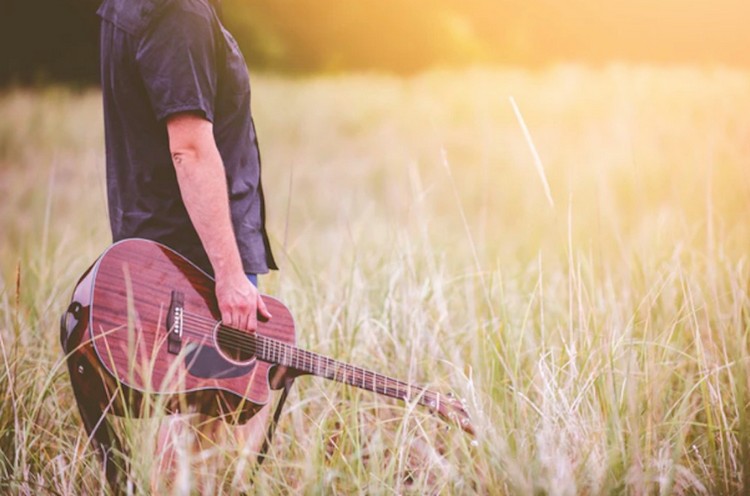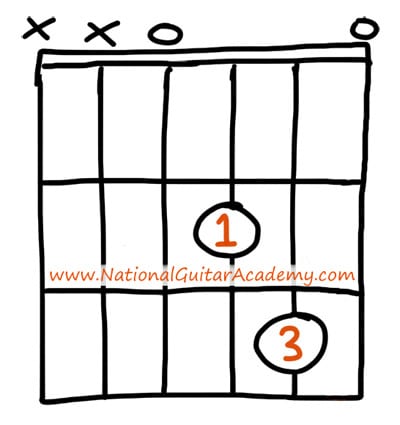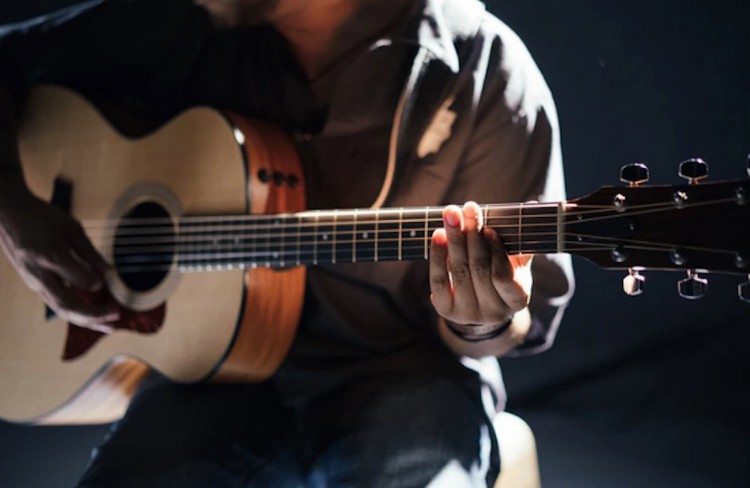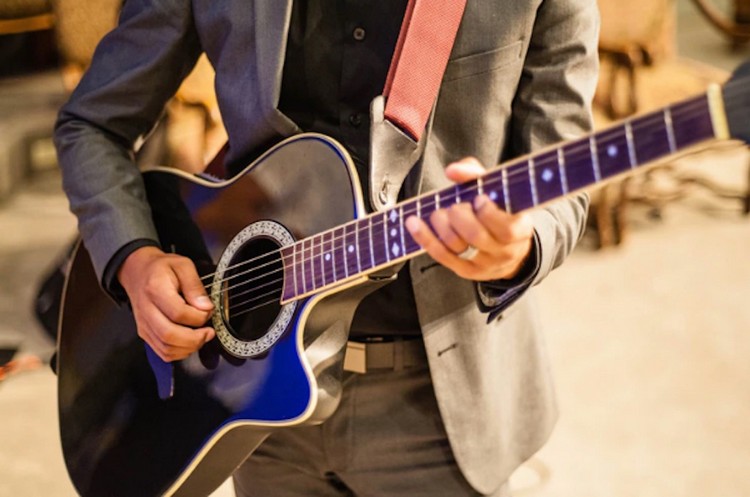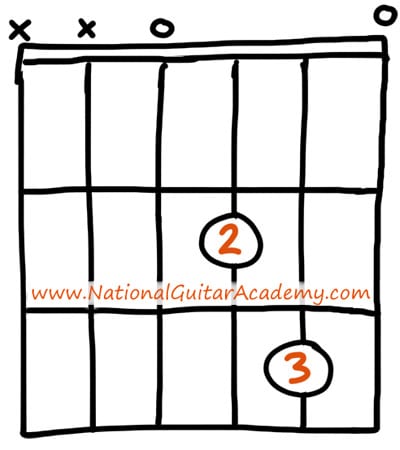Learning a good collection of guitar chord progressions for beginners helps us to learn the foundation for many different songs. Let’s explore!
Over 250,000 guitar-learners get our world-class guitar tips & tutorials sent straight to their inbox: Click here to join them
In this free lesson you will learn…
- 7 easy-to-play chord progressions
- Easy open-position chords that will spice up your playing
- The tried-and-true chord progression used all over Pop music
- How to find the similarities in chords
- How to switch between chords
Start Rocking With Simple Guitar Chord Progressions For Beginners
No matter how you do it, the journey of learning guitar is an never-ending stream of opportunities to get frustrated.
There’s the process of building and maintaining calluses; the constant learning, and the tuning of our ears and guitar so we can hear if we’re even doing this all correctly.
On top of all of this, there’s learning how to switch between a wide and ever-growing collection of chords.
If you’re pretty new to the guitar, or if you’ve been trying for a while and feel a little stuck anywhere on this road, don’t panic!
Today is the day you break through stubborn fingers syndrome and making it easier for your fingers to go from shape to shape.
In this lesson, you’ll begin building up a pile of guitar chord progressions for beginners to improve flexibility, dexterity, and muscle memory.
- We’re going to use simplified chord forms to work through these sequences, so you’ll be able to quickly work up to mastering guitar chord progressions for beginners.
- Not to mention, they sound cool!
- Just because they’re simple chord shapes doesn’t mean you won’t find yourself using them constantly!
Guitar Chord Progressions For Beginners: Em – Asus2
The first of your guitar chord progressions for beginners also happens to be a major theme running through one of the greatest-selling rock albums of all time.
The Em – Asus2 progression, or a variant of it, appears over and over again in Pink Floyd’s 1973 album Dark Side of the Moon.
From a songwriting perspective, it’s interesting to see how much mileage you can get out of an interesting combination of only two chords.
Neil Young also uses this sort of progression in quite a few of his songs, including “Down By the River” and “Cortez the Killer.”
Here are the two shapes you’ll start with.
Em (022000)
(If you don't understand the above image please read our article "How To Read Guitar Chordboxes In 60 Seconds". It will make everything clear!)
Asus2 (x02200)
The first step in getting used to changing between chords is noticing any similarities that exist between the two chords you’re practising.
With Em and Asus2, all you’re doing is taking the same two fingers and shifting them back and forth, up and down one string each.
The goal is to be able to “jump” both fingers at the same time to get to the next shape, but it’s okay to move one finger at a time to start with.
Once you’ve gotten used to the first of your guitar chord progressions for beginners, fire up that Pink Floyd album and see how much of it you can play along with.
This is a great practice technique for training your ears!
Learn 12 EASY beginner chords with our popular guide

✅ Stop struggling. Start making music.
✅ Learn beginner-friendly versions of every chord.
This is our most popular guide and it will improve your chord ability quickly! 😎
Get your own personalised guitar-learning plan 🎸
Get a custom guitar-learning plan here: Click here for GuitarMetrics™
World-Class Guitar Courses 🌎
Learn from the world's best guitar educators: Click here for our guitar courses
Guitar Chord Progressions for Beginners: G6 – Cmaj7
Before moving on to the next of your guitar chord progressions for beginners, it’s worth noting a little something about the names of these chords.
Chord names are just a way of coding the names of the notes that are in the chords.
- It may be more difficult to understand what is meant by Cmaj7 than C, but it isn’t necessary to understand the code in order to be able to play the chord.
- G6 and Cmaj7 are actually simplified versions of the G and C chords, emphasizing the things that these two chords have in common to make it easier to practice changing chords.
- The G6 features the addition of an open E string, the sixth note in the corresponding scale.
- This gives this chord a lush sound in a simple setting on the fretboard.
Below is all you need to get from G6 to Cmaj7.
G6 (320000),
Cmaj7 (x32000)
When you compare G6 to G, and Cmaj7 to C, you’ll see that there’s just one finger missing from each chord. Practice G6 to Cmaj7, and that will make practicing G to C that much easier when the time comes.
- G6 to Cmaj7, or some version of that, happens all over Bob Seger’s “Night Moves” and The Byrds’ “Wasn’t Born to Follow”.
- Just like Em to Asus2, G6 to Cmaj7 involves moving a two-finger shape back and forth between strings.
- Once you get used to moving between these two chord shapes, you can test yourself with some rhythm.
You’ll need a capo to play along with “Night Moves”, but the chords change twice as slowly as they do in “Wasn’t Born to Follow.”
- To try to play along, listen for the chord changes and try to strum each chord in time.
- It’s a great ear training exercise as well as a measure of how quickly you can change chords!
Pro-Tip: What causes our fingers to resist changing between chords is development of muscle memory.
It’s a good problem to have, because it means that your fingers are learning the chord shapes, but it takes some mental effort and a whole lot of repetition to get your fingers jumping between the shapes.
Know that it’s temporary (as well as a learning milestone) and stick with it. Soon stubborn fingers will become a distant memory!
Guitar Chord Progressions For Beginners: Em – G6
Now we’re going to combine the two basic shapes you’ve practiced for the next in your series of guitar chord progressions for beginners.
Em to G6, or some form of that progression, is found everywhere from Nirvana’s “About a Girl” – to Los Lobos’ “I Got Loaded.”
- These chords go together unbelievably well because although they don’t share the same shape, they do share most of the same notes!
- The only thing that’s audibly different between the two chords is the root, the note at the bottom of each chord.
Here are the shapes you’ll be dealing with for this progression.
G6 (320000)
Em (022000)
The genius of this two-chord progression is that you only need to move one finger! Can you see that?
- Whatever finger you have on the A string – for us it would be the middle finger, but for you it might be the first finger – stays there for each chord, serving as an anchor or pivot point.
- Whatever finger is on the E string for the G6 chord will just move over to the D string for the Em chord.
- Practicing moving one finger while the other stays still is a challenge at first, but it is super helpful in developing flexibility and dexterity.
To play along with “About A Girl,” you’d need to detune your guitar, so try playing along with Los Lobos if you don’t feel like doing that.
Guitar Chord Progressions For Beginners: Dsus2 – Asus2 – G6
If you have been practicing the above guitar chord progressions for beginners for a little while, maybe you’re ready to incorporate some completely different shapes to challenge yourself, so here we go!
This progression – Dsus2, Asus2, G6 – is important because it includes a version of each of the three most important chords in any song in the key of D major.
A key is just a family of chords. Chords can belong to a bunch of different chord families, but what makes the key is the chord that the song uses as a kind of home base.
Practice these three shapes and you will be able to play any song in the key of D!
Dsus2 (xx0230)
Asus2 (x02200)
G6 (320000)
There are two classic tunes that immediately leap to mind, both of which use the same chords in roughly the same order: CCR’s “Midnight Special” and the Tokens’ “The Lion Sleeps Tonight.”
You’ll need a capo to play along with the recording of “The Lion Sleeps Tonight,” but the entire chord progression for you is Dsus2 – G6 – Dsus2 – Asus2. Give it a try on your own!
For “Midnight Special,” the chord progression is G6 – Dsus2 – Asus2 – Dsus2. You could make a mashup of the two songs and it would work great!
These chord shapes jump around the fretboard, so take your time in getting to each chord at first. Once your fingers start to know where they need to go, it will become much easier to play in time.
Guitar Chord Progressions for Beginners: Em – G6 – Dsus2 – Asus2
November 10 marks the anniversary of the wreck of the Edmund Fitzgerald, a merchant ship that sank in a storm on Lake Superior.
That tragedy spawned the finest story song ever written – Gordon Lightfoot’s “Wreck of the Edmund Fitzgerald.”
This is not the only song that uses this example of guitar chord progressions for beginners, but it’s one with a verse that can be played over and over again. Plenty of replay value!
Other songs that use this progression include the Eagles’ “Peaceful Easy Feeling”, and “Heart and Soul” by Hoagy Carmichael.
Dsus2 (xx0230)
Em (022000)
G6 (320000)
Asus2 (x02200)
Using “Peaceful Easy Feeling” as an example, let’s cycle through these chords.
- Start with the Dsus2 with your first finger on the G string second fret, your third finger on the B string third fret.
- From there, go to the Em chord. You can use either fingers 1 and 2 or fingers 2 and 3.
- After that, you’ll go to the G6, with whatever finger is on your D string second fret moving to the E string third fret.
- Finally, move to the Asus2 chord. Again, you can use either fingers 1 and 2 or fingers 2 and 3.
Try This: Once you get the changes down for the beginning guitar chord progressions, you can start by cycling through eight strums of each chord.
From there, double your chord-changing speed by switching to four strums of each chord.
Pro-Tip: Incorporate rhythm into practising these guitar chord progressions for beginners by starting at a very slow tempo.
You can benefit from using a metronome, which will click out the beat for you and help you to develop and maintain rhythm skills!
Download our lead guitar cheat-sheet to make things easier
It's hard to understand which scales work with which keys.
So we created a cheat-sheet! A key and scale-finder that you can use again and again.

Get your personalised guitar-learning plan 🎸
Get a custom guitar-learning plan here: Click here for GuitarMetrics™
World-Class Guitar Courses 🌎
Learn from the world's best guitar educators: Click here for our guitar courses
Guitar Chord Progressions For Beginners: G6 – Cmaj7 – Dsus2
You’ve gotten your G6 – Cmaj7 chord change ready above, so now we’ll add one more shape into the mix.
Having some version of G, C, and D gives you all the chords you need to play a majority of the songs you’d like that are in the key of G.
Loads of Blues, Bluegrass, Country, Folk, and Rock music is in the key of G, so having these chord forms ready to go will prepare you for plenty of jamming situations.
Here are the chord shapes you’ll need to play this progression.
G6 (320000)
Cmaj7 (x32000)
Dsus2 (xx0230)
You can play “Midnight Special” and “The Lion Sleeps Tonight” in the key of G!
“Midnight Special” goes Cmaj7 – G6 – Dsus2 – G6.
“The Lion Sleeps Tonight” goes G6 – Cmaj7 – G6 – Dsus2.
Making little changes to these guitar chord progressions for beginners can also lead your ears to a bunch of other songs you already know.
Try this one: G6 – Cmaj7 – Dsus2 – Cmaj7. Can you hear “Twist and Shout”? How about “Good Lovin”? There are hundreds of songs that use those chords in more or less the same order.
This is why learning guitar chord progressions for beginners is a shortcut to learning multiple songs at once – they tend to use the same chords, just in a different order and with different timing.
Guitar Chord Progressions for Beginners: G6 – Dsus2 – Em – Cmaj7
The ultimate in your guitar chord progressions for beginners is this combination: G6 – Dsus2 – Em – Cmaj7.
This chord progression is so powerful that since the 1980s it has taken over all the other chord progressions and created a chord progression empire that has yet to be defeated.
We will never ever run out of songs with this chord progression, and here is the Axis of Awesome to prove it to you.
Here’s everything you need:
G6 (320000)
Dsus2 (xx0230)
Em (022000)
Cmaj7 (x32000)
Take your time getting from chord to chord first.
Beginning to practice too quickly before your fingers know where they are going can keep you stuck for longer than necessary.
If you are patient with yourself and work out each chord change, you’ll find that some are easier than others. Stick with the difficult changes until you can feel your fingers calm down – that’s efficient practice!
Once you are comfortable with each of the changes in this cycle, try playing one measure of each. You’re on your way to creating your own infinitely long medley of songs that go like this!
The Best Practice Of Guitar Chord Progressions For Beginners
The guitar chord progressions for beginners that we’ve reviewed in this article have all been put in a certain order for a certain purpose.
However, it is very important that you know that any chord can go anywhere in any order.
Take these simple chord shapes and put them in an order that sounds interesting to you.
These are the building blocks of songwriting!
Recommended Resources
Did you enjoy this free guide? We’ve got plenty more content to help you along your guitar journey below!
- Best Online Guitar Lessons
- Music Theory For Beginners
- How To Play In Time
- Rhythm Guitar Lessons
- Learning To Play Guitar
What Type of Guitarist Are You?
Take our 60-second quiz & get your results: Take The Quiz
Join the world's best online guitar school 🌎
- Get your own personalised guitar learning plan (customised just for YOU).
- World-class online guitar courses. Learn at your own pace.
- Community Campus & Learning Forum - A friendly community! Connect with our team & students. 😊
- Beginner Song library with chordsheets, tabs and tips. (Songs suitable for all levels!)
- Regular live streams, seminars and Q&A sessions - Learn from world-class guitar educators. Get all your questions answered!
Click here to learn more about National Guitar Academy membership 
Cool Guitar T-shirts 😎
Look cooler! Check out our merch: Click here to see our merch store
Want free guitar tips and video lessons delivered to your inbox?
Join over 250,000 other guitar learners and subscribe to our guitar-tips-by-email service. (It's free.)
We'll send you a series of lessons that will move you to the next level of your guitar journey.
Learn how everything fits together quickly, easily and effectively. We share ninja tips (for instant fun!) but also timeless fundamentals that will deepen your understanding.

Popular Lessons
How To Learn Guitar: An 11-Step Programme For Beginners
How To Choose The Perfect Beginner Guitar
More Cool Guitar Stuff
Learn about National Guitar Academy: About Us
Visit our YouTube channel for fun guitar videos.
Join us on Facebook for daily guitar tips.
Listen to our Learn Guitar Podcast for rapid guitar progress.
Check out our free chord lessons.
Get our best guitar tips & videos
Where should we send it?
Where should we send it?
Get our best guitar tips & videos


